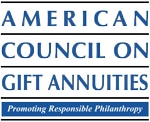 The American Council on Gift Annuities announced last week that its suggested rates for Charitable Gift Annuities, or CGAs, would remain unchanged from last year. Here’s a look at the assumptions that lead to the rates.
The American Council on Gift Annuities announced last week that its suggested rates for Charitable Gift Annuities, or CGAs, would remain unchanged from last year. Here’s a look at the assumptions that lead to the rates.
The Council meets at least annually to review its rate recommendations and consider adjustments to its assumptions.
Clients often ask where the rates that 95% of charities rely on, come from. They come from five assumptions.
1. Your charity will realize 50% of the face value of each gift. At the death of the one or two people receiving income from a CGA (the annuitant/s), what remains from the face value of the gift is transferred to your charity. If it’s a $25,000 gift annuity, you should get $12,500. For that to happen, the other assumptions have to hold. What’s your experience been?
(The annuitants are usually the donors, but not always. Think of a donor couple arranging for an adult child to receive payments for life.)
2. Annuitants will comply with mortality assumptions. I know people who I hope long outlive their projected mortality. There are a few others who are welcome to go at any time.
ACGA uses the Annuity 2000 Mortality Tables. (Click the link to see how long the National Association of Insurance Commissioners says you’ll live.) There are two tables, for male and female. To be conservative, ACGA assumes all annuitants are female (live longer) and one year younger than their real age (so they’ll get a lower rate of payment).
Mortality is a complex subject. It’s based on large numbers and doesn’t apply to individuals, so if you don’t like what you see in the table above, there’s still considerable hope for you. But, for gift annuities to work there has to be an assumption around each annuitant’s life expectancy, and mortality tables are the best we’ve got.
3. Your charity will pay administrative fees of 1%. That’s taken as a percentage of your gift annuity reserve fund, which many states require. My clients are small- and mid-size charities. For their gift annuity programs 1% is wildly low. Five to 8% is more what I see.
What’s your experience?
4. The reserve fund will earn 4.25% annually. The reserve fund has to be invested and the Council assumes you’ll earn 4.25% each year. That’s been highly unlikely for the past 3 to 4 years because all but the largest reserve funds are conservatively invested. Deduct fees from earnings and that’s your earnings net of expenses. For a lot of charities it’s a negative number recently.
What do you see?
5. Annuitants are paid quarterly. Payments can also be monthly, semi-annual or annual. Quarterly is most common in my experience. If payments are less frequent then your reserve fund will enjoy a higher balance as money remains in longer. Most charities allow donors to choose their payment frequency.
Those are the assumptions that translate into the Council’s suggested rates for immediate payment gift annuities. I haven’t covered deferred payment annuities.
A history lesson: in the mid-90’s there were two federal antitrust cases naming ACGA as defendant and alleging price-fixing in the rates. Congress twice stepped-in with laws to protect ACGA, gift annuities and all the charities (and others) that rely on the recommended rates. Check out this short summary of the legal drama.

